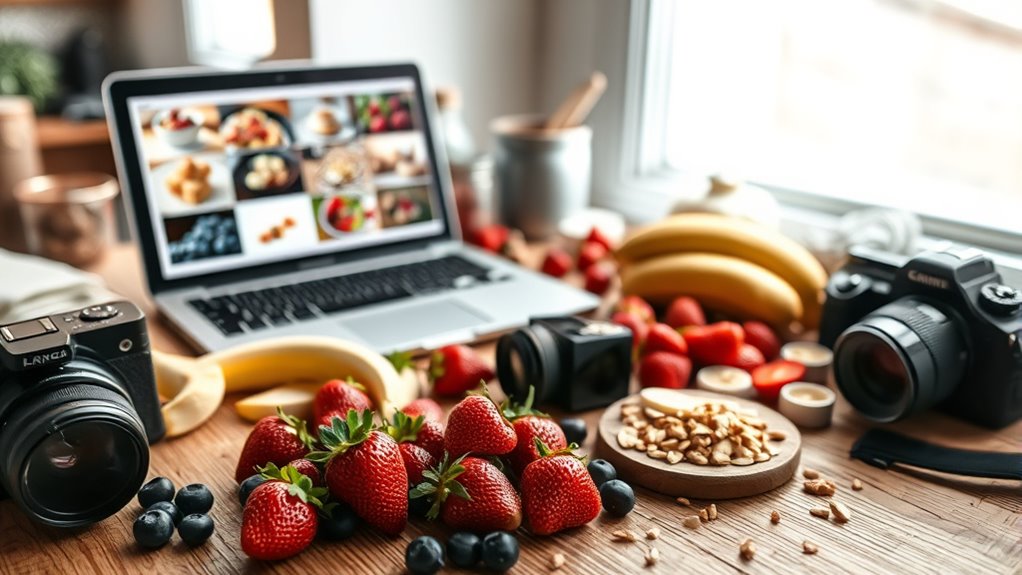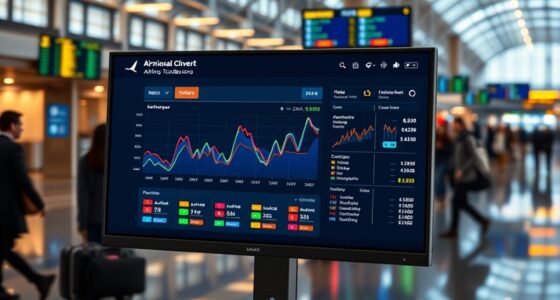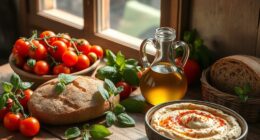To train a custom model on your recipe photos, start by organizing and annotating your images—label ingredients, presentation styles, and utensils accurately. Choose an easy-to-use machine learning platform that supports your dataset and labels. Then, prepare your images with data augmentation techniques to improve diversity. Train your model, evaluate its accuracy, and refine it as needed. If you keep exploring, you’ll discover step-by-step methods to perfect your recipe recognition system.
Key Takeaways
- Collect and organize diverse, high-quality recipe images with consistent lighting and annotations for effective training.
- Annotate images accurately by labeling ingredients, presentation styles, or utensils to improve model differentiation.
- Use data augmentation techniques like rotation and brightness adjustments to enhance dataset diversity and robustness.
- Choose a platform that supports transparent, ethical AI practices and offers user-friendly tools for custom dataset management.
- Integrate the trained model into an app or cloud service, ensuring scalability, fast response times, and regular updates for accuracy.
Gathering and Organizing Your Recipe Images
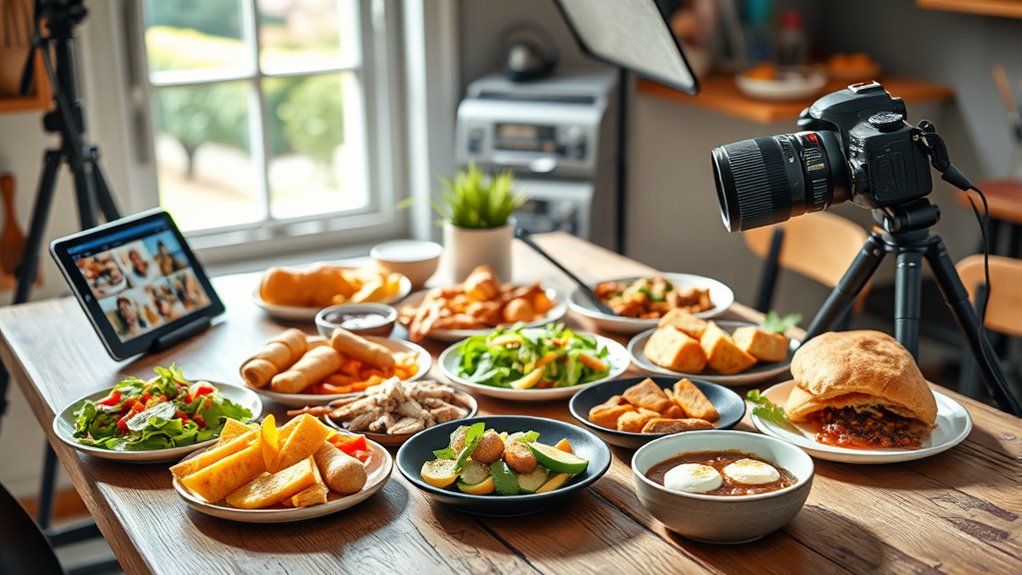
To build an effective custom model, you need a solid collection of recipe images organized for easy access and labeling. Start by gathering photos that showcase various dishes, highlighting ingredient substitutions and plating techniques. These variations help your model recognize different versions of the same dish, enhancing its flexibility. Organize your images into folders labeled by dish type, ingredients, or presentation styles. Consistent lighting and angles improve recognition accuracy. Be sure to include images that emphasize different ingredient substitutions, like dairy-free or gluten-free options, and varied plating techniques to capture diverse presentation styles. Incorporating diverse examples that emphasize different presentation contexts and environments can further enhance recognition accuracy and robustness. This organization guarantees that when you train your model, it can accurately identify dishes and their variations, making your system more reliable and adaptable for real-world applications. Including images that demonstrate lighting conditions and ambient settings can help the model adapt to various real-life scenarios. Additionally, considering the use of data augmentation techniques can expand your dataset and improve model performance.
Annotating and Labeling Your Photos for Model Training
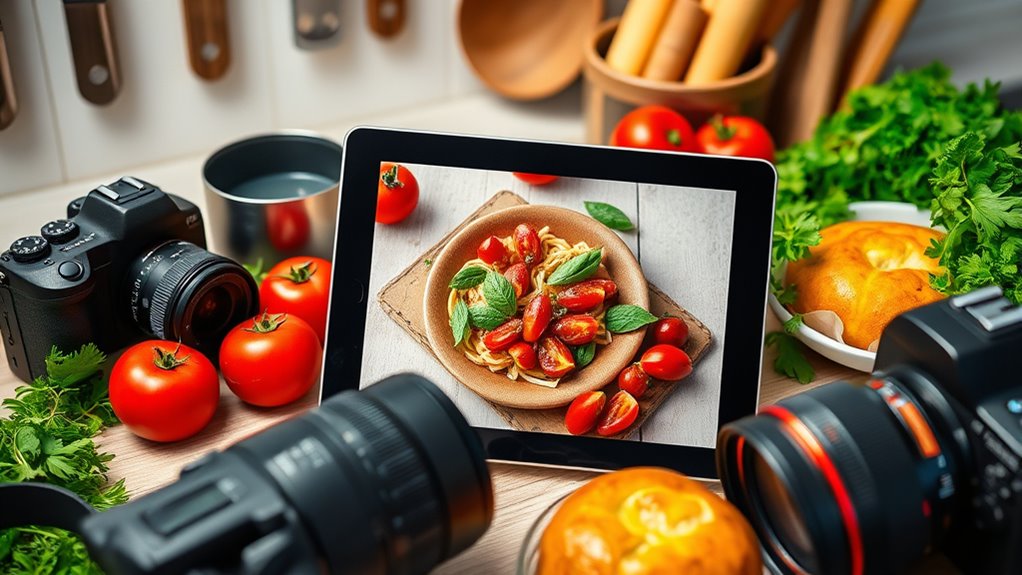
After organizing your recipe images, the next step is to annotate and label them accurately. Using effective labeling techniques guarantees your model learns correctly, so take your time to identify key features like ingredients, utensils, or presentation styles. Annotation tools can simplify this process by offering user-friendly interfaces for drawing bounding boxes or tagging objects within your photos. Choose tools that support your desired labels and make bulk labeling easier. Be consistent with your labels to avoid confusion later. Proper annotation helps your model distinguish between different dishes or ingredients, improving its accuracy. Remember, precise labeling now saves you time during training and results in a more reliable, effective model.
Choosing the Right Machine Learning Platform or Tool
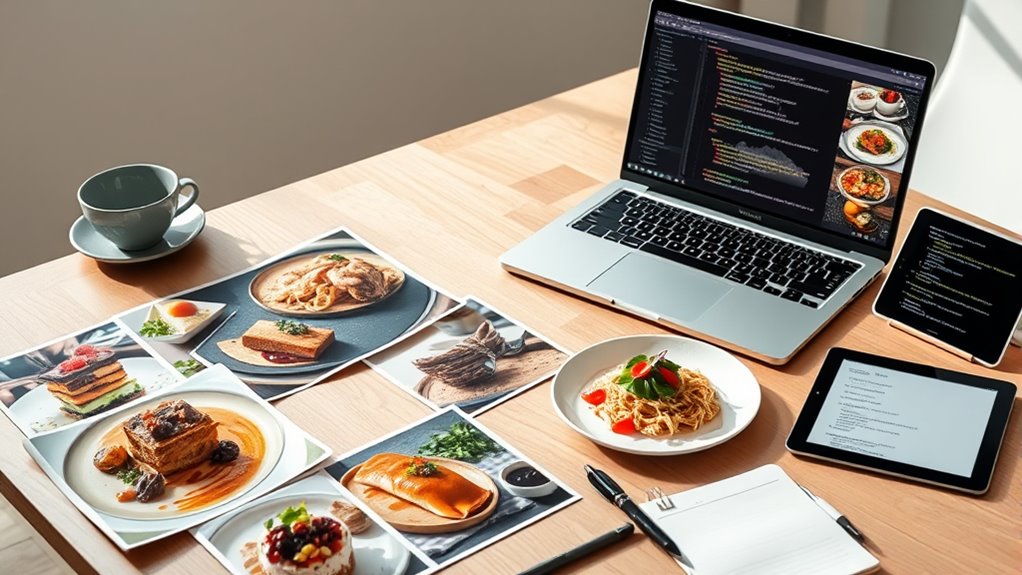
Selecting the right machine learning platform or tool is a vital step that can greatly influence your project’s success. First, consider platforms that prioritize model interpretability, so you can understand how your model makes decisions about your recipe photos. Second, evaluate ethical considerations, ensuring the tool supports fair and unbiased training processes. Third, envision yourself steering options like:
- User-friendly interfaces that simplify model development
- Robust support for custom datasets and labels
- Built-in features for transparency and explainability
Additionally, understanding the security of your data is crucial to protect your project from potential vulnerabilities. Incorporating platforms that emphasize model interpretability can provide clearer insights into how your model processes your images, fostering trust and enabling better troubleshooting. Moreover, choosing tools that support training with diverse datasets can improve your model’s robustness and accuracy across different recipe images. Recognizing the importance of ethical AI practices ensures your training process aligns with fairness and bias mitigation efforts. Emphasizing environmental considerations can also help ensure your model training process aligns with sustainable practices and reduces ecological impact.
Preparing Your Dataset for Training
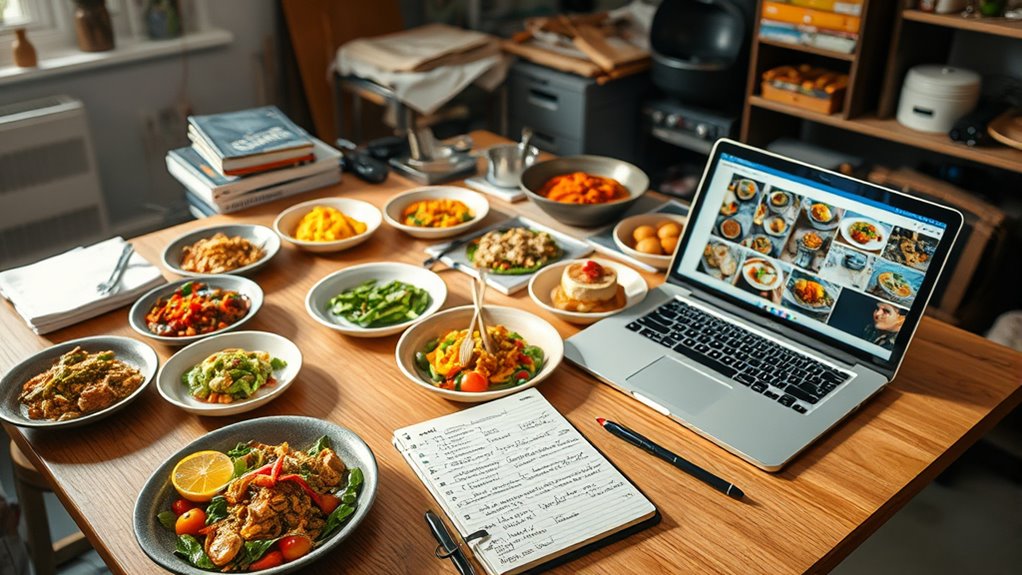
Before you start training your model, preparing your dataset is essential to guarantee accurate and reliable results. Focus on ensuring recipe diversity by including various cuisines, presentation styles, and ingredient combinations. This variety helps your model recognize different types of recipes more effectively. Additionally, use data augmentation techniques like rotating, flipping, or adjusting brightness to expand your dataset without collecting more images. Data augmentation enhances model robustness by simulating real-world variations. Make sure your images are high quality and properly labeled, with clear annotations of ingredients or dish types. Be aware of potential resources and tools available that can assist in managing and organizing large datasets. Incorporating data quality standards ensures consistency and reduces errors during training. Proper dataset balance helps your model avoid bias toward certain recipe types. Paying attention to training data diversity ensures your model can generalize well across various recipe categories. Moreover, labeling consistency plays a crucial role in training accuracy by ensuring all annotations are uniform and precise. By carefully curating your dataset with diverse recipe images and applying augmentation, you set a strong foundation for training a reliable, accurate model that performs well across different recipe categories.
Training the Model With Your Custom Data
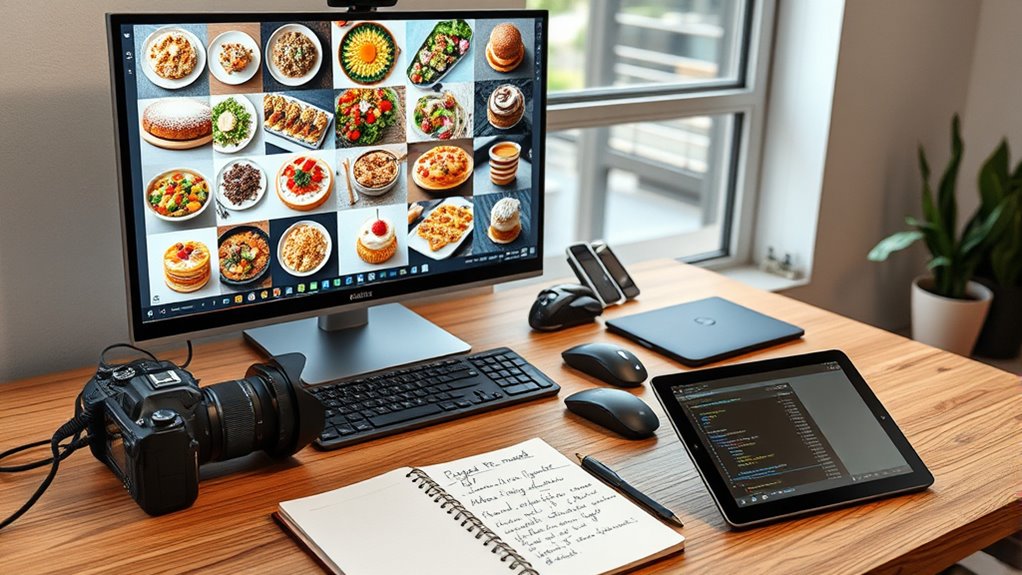
With your dataset prepared and augmented, you can now focus on training your model to recognize different recipes. Start by feeding your images into the training process, which will help your model learn recipe categorization. As the training progresses, you’ll want to visualize the process, imagining: 1. The model adjusting weights to better distinguish a pizza from a burger. 2. Image augmentation techniques like rotation, scaling, and color shifts enriching your dataset. 3. The model becoming more confident in classifying diverse dishes as it sees more varied examples. 4. Ensuring your training process accommodates different training data formats to optimize learning outcomes. Additionally, understanding how sound vibrations influence neural networks can inspire new approaches to model tuning and optimization. Incorporating website cookies can also help track your model’s performance improvements over time. Exploring model evaluation techniques can further enhance your training process by identifying areas for improvement. Moreover, applying principles from ethical hacking such as systematic testing can help identify potential biases or weaknesses in your model’s performance.
Evaluating and Improving Your Model’s Accuracy
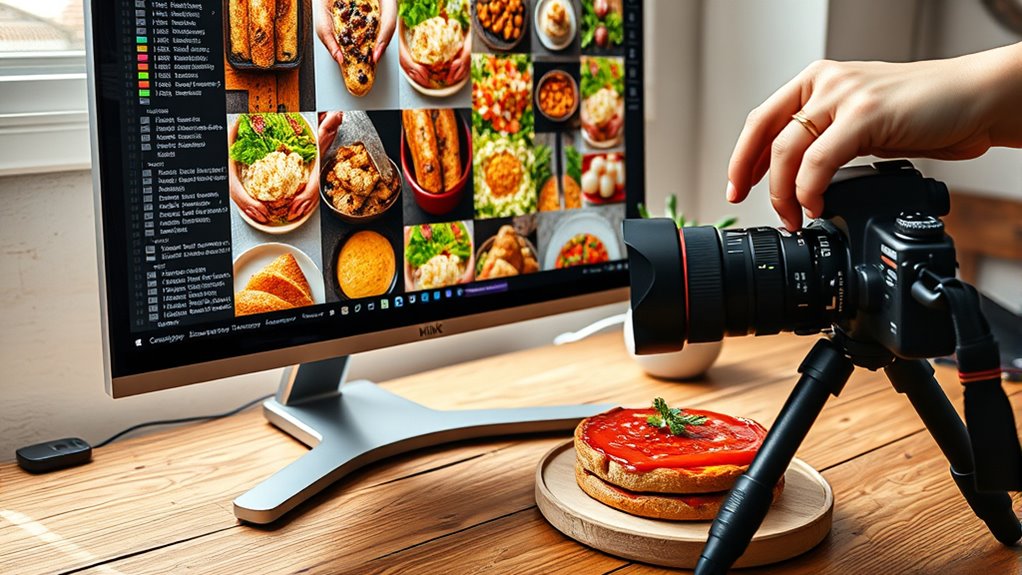
To improve your model, you need to assess how well it performs on new recipe photos. Start by measuring key metrics like accuracy and precision to identify where it falls short. Then, apply fine-tuning strategies to boost its performance and make it more reliable. Regularly reviewing your model’s performance metrics can help you identify specific areas for improvement and ensure ongoing accuracy. Incorporating training data quality checks can further enhance the model’s robustness and prevent overfitting. Additionally, understanding the exfoliation effects of glycolic acid can guide data augmentation strategies to improve model recognition of skin-related features.
Measuring Model Performance
Evaluating your model’s performance is essential to guarantee it accurately recognizes and classifies recipe photos. You should start with model validation, splitting your data into training and validation sets to test how well your model generalizes. Next, focus on accuracy metrics like precision, recall, and F1 score to get a clear picture of its strengths and weaknesses. Visualize this process as:
- Running your model on new images to see how often it gets it right
- Comparing predictions with actual labels to spot errors
- Adjusting your training process based on these insights to boost performance
Fine-Tuning Strategies
Building on your validation efforts, fine-tuning strategies focus on improving your model’s accuracy based on its performance insights. Transfer learning allows you to leverage pre-trained models and adapt them to your specific recipe photos, saving time and resources. To boost accuracy further, apply data augmentation techniques such as rotating, flipping, or adjusting brightness, which expand your training dataset and help your model generalize better. Regularly evaluate your model’s performance metrics, and if needed, fine-tune hyperparameters or retrain with augmented data. This iterative process helps identify weaknesses and refine your model’s ability to recognize diverse recipe images. By combining transfer learning with targeted data augmentation, you maximize your model’s potential and achieve more reliable results in your custom recipe photo classifier.
Deploying Your Personalized Recipe Recognition System
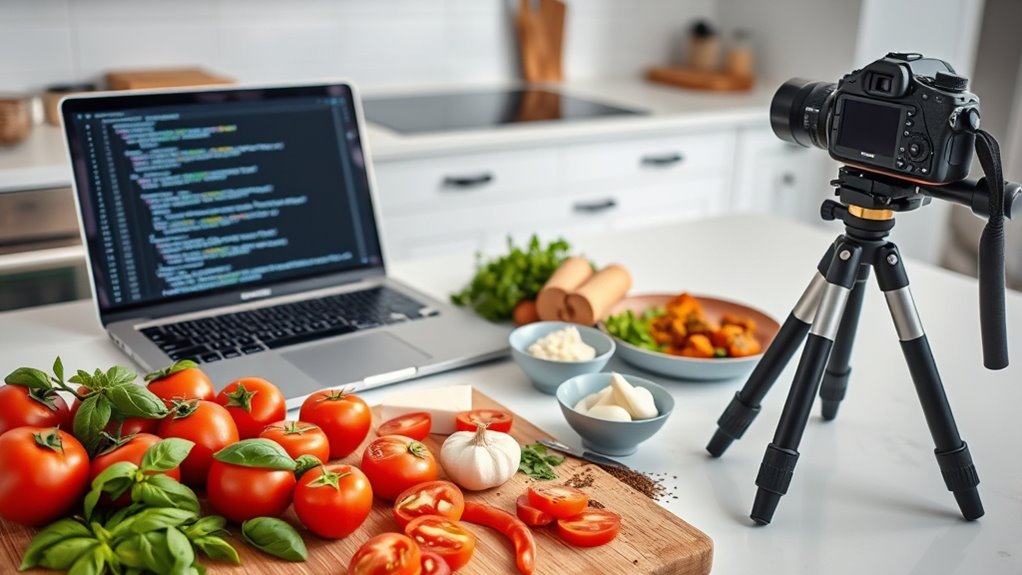
Once your model is ready, you need to choose the best deployment strategy to make it accessible. You’ll also want to contemplate how to seamlessly integrate it into your app and keep it updated over time. This way, your recipe recognition system stays accurate and reliable for users.
Model Deployment Strategies
Deploying your personalized recipe recognition system effectively guarantees it can be accessible and reliable for users. To do this, focus on strategies like model scalability and cloud deployment. Imagine:
- Scaling your model seamlessly to handle increasing user demand without slowing down.
- Using cloud services to deploy your system globally, ensuring quick access from anywhere.
- Automating updates so your model stays current with new recipes and images.
Integration With Apps
Integrating your personalized recipe recognition system into mobile or web apps is essential for delivering a seamless user experience. Effective app integration ensures that users can easily upload photos and receive instant recipe identifications without friction. To achieve this, embed your model into your app’s backend or leverage cloud services for smooth deployment. Clear API endpoints enable quick communication between your app and the recognition system, making the process intuitive. Prioritize fast response times and accurate results to keep users engaged. Consider designing a clean interface that guides users through photo uploads and displays results clearly. Remember, a well-integrated system enhances satisfaction, encourages repeat use, and builds trust. Ultimately, seamless app integration transforms your model from a technical tool into a valuable feature for your users.
Maintenance and Updates
Maintaining and updating your personalized recipe recognition system is essential to guarantee it continues to perform accurately and reliably over time. To do this effectively, focus on three key steps. First, implement clear model versioning so you can track different iterations and revert if needed. Second, establish update protocols that specify when and how to retrain your model with new images or recipes. Third, regularly evaluate your system’s performance by testing it with fresh data, identifying potential drifts or inaccuracies. By following these steps, you ensure your system stays current, adapts to new recipes, and maintains high accuracy. Consistent maintenance and updates keep your model robust, saving you from unexpected failures and ensuring continuous reliable recognition.
Frequently Asked Questions
How Much Data Is Needed for Effective Recipe Image Training?
For effective recipe image training, you need a sufficient data volume to cover variety and complexity. Generally, a few thousand well-annotated images work best. Focus on annotation quality, ensuring labels are accurate and detailed, as this greatly impacts model performance. Higher data volume with poor annotations won’t perform as well, so prioritize quality over quantity. With the right balance, your model will learn to recognize recipes accurately.
Can I Use Existing Pre-Trained Models for My Recipe Project?
Ever wondered if pre-trained models can jumpstart your recipe project? Absolutely! You can leverage transfer learning, which allows you to adapt existing models to your specific needs, saving time and resources. Data augmentation further enhances your dataset, improving accuracy. Using a pre-trained model means you don’t have to start from scratch, making your training more efficient and effective. Isn’t that the smart way to approach your culinary AI journey?
What Hardware Requirements Are Ideal for Training Large Datasets?
For training large datasets, you need hardware optimized for high performance, like GPUs with ample VRAM and fast processors. This setup speeds up training and handles complex models efficiently. Incorporate data augmentation techniques to enhance your dataset without adding physical hardware. Prioritize hardware with good thermal management and upgrade options, ensuring smooth training sessions. This combination helps you achieve better results faster and more reliably.
How Do I Handle New Recipes or Images After Initial Training?
Did you know that models can improve accuracy by up to 15% with incremental learning? When you get new recipes or images, you should update your model incrementally, rather than retraining from scratch. Use data augmentation to diversify these new images, helping your model adapt better. This approach saves time, keeps your model current, and guarantees it recognizes new recipes effectively without losing prior knowledge.
What Are Common Challenges Faced During Custom Model Training?
When training a custom model, you face common challenges like overfitting issues, where your model becomes too tailored to your training data and performs poorly on new images. Label inconsistencies also cause problems, confusing the model and reducing accuracy. To overcome these, you should gather diverse data, verify accurate labeling, and use techniques like validation sets to monitor overfitting, ultimately improving your model’s generalization.
Conclusion
Now that you’ve navigated the nuanced process of nurturing your niche knowledge, you’re ready to realize remarkable results. With patience, practice, and passion, your personalized recipe recognition model will prosper and perform perfectly. Keep experimenting, exploring, and enhancing your expertise. Remember, persistence and precision pave the path to success. So, stay steady, stay savvy, and savor the satisfaction of showcasing your stunning, skillful, and super-specific culinary creations!
